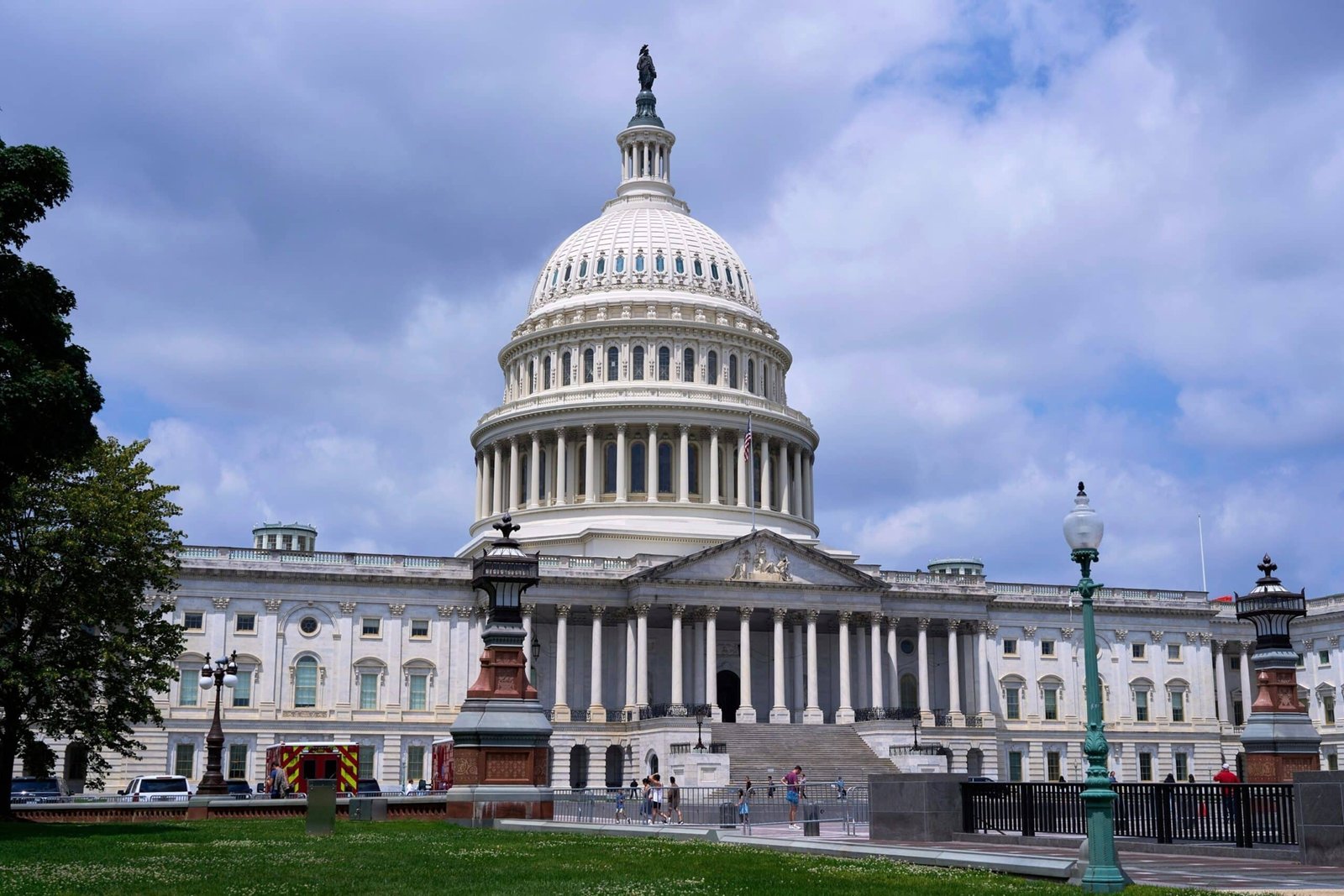Although most of the Senate Republicans left an informative session of closed doors on the recently released provisions in the part of the Senate Committee of the Finance Committee of the Megabill of President Donald Trump to finance his second -term agenda, sufficiently posing important concerns that could mean a difficult path for the legislation.
The leader of the majority of the Senate, John Thune, can afford to lose only three Republican senators when the “great and beautiful Trump bill goes to the Senate’s floor.
At this time, there are no three that expressly express that they will vote against the package, but there are at least many who are raising very serious concerns about the bill, questioning whether the mass package will have the support you need to approve the Senate.
Senator Ron Johnson, a deficit hawk that has long criticized the expense in the bill, said he is not supporting it “at this time.”

The Capitol is seen in Washington, on June 9, 2025.
J. Scott Applewhite / AP
“We are not doing anything to alter the course of the past and the future in this country,” he said, and pointed out that when the Congress Budget Office report comes later this week, “you will see why I am not particularly stimulating” in the legislation.
“There are many good things about what the house is doing,” he added. “The problem is that you just don’t meet the moment.”
Johnson also insisted that the bill would not reach the Trump desktop for the deadline of the Republicans.
“No, not for July. In any way. We haven’t had the discussions we need,” he said.
Senator Josh Hawley said he was “alarmed” for what he heard at the meeting. His greatest concern is the way in which changes in medicality to suppliers could damage rural hospitals in Missouri.
“Is this a completely new system that will disburse rural hospitals effectively for what? To pay solar panels in China? I mean, this needs a lot of work, in my opinion,” he said.
Senator Rick Scott said that while he is optimistic about the bill, he has serious concerns about the provider’s tax provisions.
“I am optimistic, okay, that we can all unite and we will receive a fiscal sanity and we will also make sure that the states like mine that did not expand their medicaid are not unfairly treated,” said Scott.
Senator Rand Paul is also expected to oppose legislation due to the language that would increase the federal debt limit by $ 5 billion.
Despite these objections, most Senate’s Republicans seemed optimistic about the state of the bill.
Steve Daines senator remained optimistic about Thune’s ability to carry the bill in the finish line.

The leader of the majority of the Senate, John Thune, answers a question from the media while walking to his office at the Washington Capitol, on June 5, 2025.
Shawn Thew/EPA-EFE/Shuttersock
“It was delivered every time they need it, either in budgetary resolutions, a draft reconciliation law, for a year [continuing resolutions] – He’s hitting a thousand, “said Daines.” It is always difficult, but it is delivering it. I wouldn’t, I wouldn’t bet against him right now. “
Republicans are using a legislative procedure called reconciliation, which limits it to taxes and expenses, to try to approve the bill with a simple majority. But the president of the House of Representatives, Mike Johnson, warned the Senate to make minimum changes in the bill to ensure that it can be approved, given the thin margin of shaving in the lower chamber.
There are also several senators who have conditioned their support to the bill on certain proposals in the Senate version.
Here are potential conflict points in the legislation:
State and local tax tax
The legislation of the Senate as written would maintain the limit of state and local tax deductions (PALT) at $ 10,000 per year, while the Chamber’s bill offers deductions of up to $ 40,000 per year for those who earn less than $ 500,000 per year.
Some Republicans of the House of Representatives have said that they will not vote in the final bill if the deduction is less than the $ 40,000 that they negotiate carefully.
Senators have said that the $ 10,000 limit is currently only a position score, it is not finished and is still being negotiated. The inclusion of a value allows the non -partisan Congress budget office to begin to write down the bill, but the senators say that the score could be modified as the salt lid changes.
Senator Markwayne Mullin, who has been a key negotiator with the Republicans of the House of Representatives about Salt, was actively in conversations with a Republican of the Hard Line Salt Chamber, the representative Mike Lawler, who said after the text of the Senate Finance Committee fell on Monday not to support the bill if it would be sent to the camera with its current changes.
“I talked to Mike about it. Yes, we understand it. We are in a …” Pause, “Place,” Mullin said.
Disease insurance
Similar to the camera version, the Senate bill implements the work requirements about Medicaid for “capable body adults who choose not to work and do not have dependent children or older parents under their care.”
It also increases the frequency of eligibility verifications for adults with capable body.
Healthy adults without dependents can work, participate in a job training program, register in school or be volunteers for 20 hours per week to receive the cover of taxpayers subsidized.
It also ends the payments of Medicaid financed by taxpayers for abortion services and gender transition procedures and guarantees that immigrants who lack permanent legal status do not receive benefits from Medicaid.
The biggest difference between Chamber and Senate plans to reduce “waste, fraud and abuse” in Medicaid involves the supplier tax, a tax imposed by the State on medical care providers used mainly to help finance the state programs of Medicaid. From 2027, Senate legislation would reduce the taxes of the medical care provider in the states that chose to expand Medicaid to 3.5%, below 6% in the Chamber’s bill, which means that the load of the states to finance Medicaid could be higher under the version of the Senate.
Taxes
The Senate version permanently extends Trump’s tax cuts 2017, something that Senate Republicans say it is essential for companies and families that seek to plan the future.
Nor does it include taxes on tips or taxes on extra hours, a key priority of Trump. The bill allows deductions of up to $ 25,000 in qualified tips and deductions of up to $ 12,500 in extra time. Meanwhile, the house version does not have an explicit limit in overtime advice and deductions.
The Senate bill would also offer older people a new tax deduction of $ 6,000, more generous than the deduction of $ 4,000 in the Chamber version.
It would also make the diverse and other permanent tax incentives, including the spending of investments in equipment and research and development.

The president of the House of Representatives talks about his discussions with Elon Musk this week while he meets journalists to discuss the work on the bill of tax exemptions and expenses of expenses of President Donald Trump, in the Washington Capitol, on June 4, 2025.
J. Scott Applewhite / AP
Children’s fiscal credit
The Senate bill supports the fiscal credit of the children of $ 2,500 in the version of the House of Representatives at $ 2,200 per child. Like the house, it excludes families without income.
The bill also establishes savings accounts for newborns, similar to the Chamber’s bill.
Debt limit
The Senate package includes an increase of $ 5 billion to the federal debt limit, higher than the $ 4 billion from the camera. Congress must act before autumn principles to increase the debt limit or risk breach.
Eliminating the tax credits of IRA
The version of the Senate phase to the fiscal loans of solar energy that were part of the Law to reduce inflation at a slower pace than the version of the Chamber by allowing more projects to access the credits before they finish.
The Senate bill also eliminates hundreds of billions of dollars of Ira subsidies, such as immediately putting the fiscal credit of electric vehicles and its “lease escape”, similar to the camera bill.





